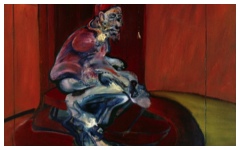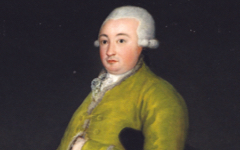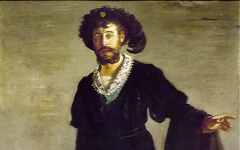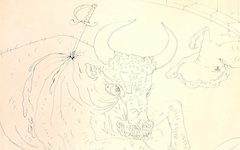Art On Stage (Theatre)
Painting is a performance. Every day artists enter their studio and stand in front of their easel, brush in hand, ready to paint. They are alone, like an actor on a stage. No-one can help them. This aspect of painting is deeply ingrained in the creative mind. At least three major figures in the Renaissance – Luca Signorelli, Michelangelo and Albrecht Dürer – produced art that has been described by modern scholars as performative. David Summers wrote: “For Michelangelo, the idea of art as a performance had the deepest significance. To conceive and realize – or perform – ever more difficult things was a sign of election and of spiritual progress.”{ref1}
Most Recent Articles
All Articles (Alphabetical by Artist, then Title)
If it looks odd, there must be a reason. See Balthus horsing around.
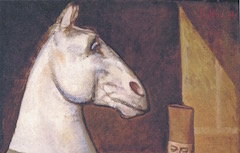
Balthus’ The Moroccan Rider with His Horse (1935)
An easy-to-recognize demonstration of how artists fuse the studio and their subject into one image

Coello’s St. Louis Worshipping the Holy Family (c.1665-8)
One of the easiest ways to find unseen features in paintings is to look for the artist's initials. Daumier included them more than most.
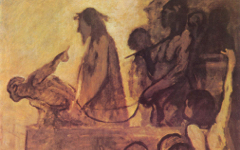
Daumier’s Ecce Homo (c.1849-52)
How Daumier turned a kettle-drum into symbols...
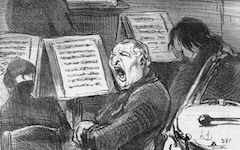
Daumier’s The Orchestra.. ..During A Tragedy (1852)
Is Degas' Little Dancer just a dancer, a study in realism? Or is she......?
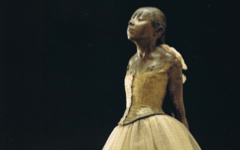
Degas’ Little Dancer Aged Fourteen (1879-81)
Self-representation was as common in the early 15th century as the 20th and today
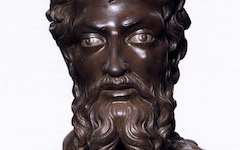
Ghiberti’s St. John the Baptist (1412-16)
A 20th-century version of medieval angels playing stringed instruments. See how.

Lichtenstein’s Girl with an Accordion (1961)
A pipe may be a pipe for René Magritte but a piano is not a piano for Roy Lichtenstein

Lichtenstein’s Piano (c.1961)
Find out how Manet's observations of scenes in Parisian cafés are really something else entirely

Manet’s Café-Concert (1878)
Don't forget to imagine what can't be seen: the artist's viewpoint
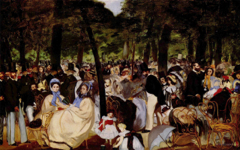
Manet’s Music in the Tuileries (1862)
This magical composition hides a complex thought of seeming effortless construction: a masterpiece of the first order

Manet’s Tragic Actor (1865-6) Part 1
There is more to the Tragic Actor than meets the eye. Find out what's there that others cannot see.
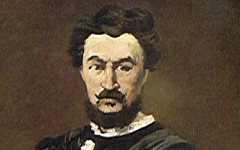
Manet’s Tragic Actor (1865-6) Part 2
Learn how Picasso used another artist's name to represent his own identification with the great masters of the past
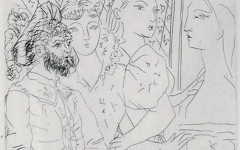
Picasso’s Three Actors (1933)
How the setting is so rarely what you think....you must think differently
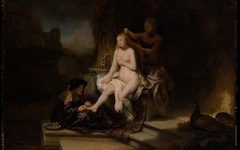
Rembrandt’s Bathsheba at Her Bath (1643)
If you like Renoir but can't see Raphael, you won't see Renoir's Raphael

Renoir’s Dance in the Country (1883)
A much-loved painting contains a marvelous self-portrait in the clouds

Titian’s Presentation of the Virgin in the Temple (1534-38)
Discover how the figure of an actor by Velazquez contains far more than just the figure of an actor
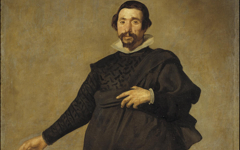
Velazquez’s Pablo de Vallodolid (1636-7)
Sometimes one of the secrets of art is so obvious, no-one sees it

Veronese’s The Marriage at Cana (1563)
Artists often identify with other artists, using them as an alter ego. Here is an exceptionally clever one.
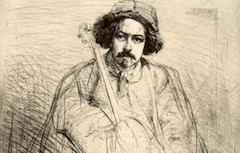
Whistler’s J. Becquet, Sculptor (1859)
© Simon Abrahams. Articles on this site are the copyright of Simon Abrahams. To use copyrighted material in print or other media for purposes beyond 'fair use', you must obtain permission from the copyright owner. Websites may link to this page without permission (please do) but may not reproduce the material on their own site without crediting Simon Abrahams and EPPH.

